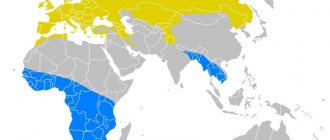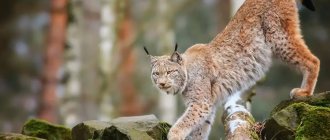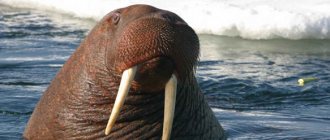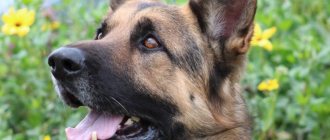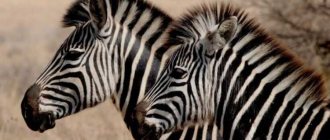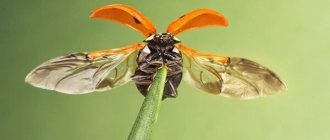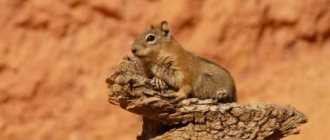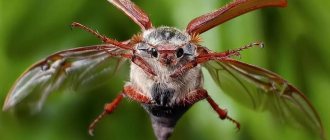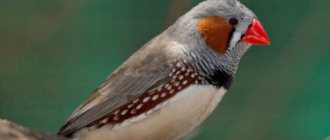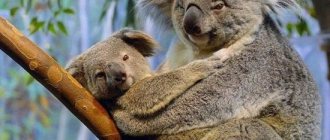Koalas are cute creatures that can often be seen on tree branches. Thanks to their passive and measured lifestyle, round shape and miniature eyes, they resemble plush toys. And their drowsiness and laziness often become reasons for jokes in cinema and animation. However, creatures that are simple at first glance have many interesting features and traits unique to their species.
Koalas spend most of their lives in trees
Origin of the species
Scientists still cannot come to a conclusion when exactly these animals appeared. Some believe that their distant ancestors lived during the late Miocene: 11-5 million years ago. Others believe that the first koalas began to populate Australia in the Pliocene: 5-3 million years ago.
Since the herbivore has practically no family ties with other animals, despite some common features with bears, it is not possible to more accurately establish their ancestors and evolutionary features.
Koalas are not easy to spot in trees
Enemies of the koala animal in the wild
The animal's natural enemy is the wild dog. Dingo rarely attacks, but then medical attention is often necessary. There is a specialized clinic for koalas near Sydney, where they are treated after such attacks and after the animal was hit by a car.
Another enemy of the koala is man, due to the fact that he increases the number of roads in the forests of Australia. Due to their clumsiness and slowness, koalas often die under the wheels of cars.
Koalas often get cystitis, conjunctivitis, sinusitis, and chlamydia. The immunodeficiency virus, the so-called retrovirus, leads to the death of the animal in 80% of cases. It causes lymphoma, malignant tumors and damage to the immune system.
History of discovery
Since these animals live in Australia, history experts can assume that they were first discovered by Tim Cook, a famous traveler who discovered these lands in 1770, after which he equipped expeditions several more times. However, the navigator did not meet the koalas due to simple bad luck. Since the animals spend all their time in the trees and move little, travelers who did not even think of looking at the eucalyptus branches lost sight of them.
Humanity first became acquainted with these animals in 1802, when the governor of New South Wales received a parcel from a soldier, Barallier.
Inside the box he found the carcass of an unknown creature preserved in alcohol. This find aroused great interest among scientists, and they began to study it. However, a year later people met koalas in person, and some time later a large article was published in one of the scientific journals, describing this animal in detail. Interesting fact : despite the fact that koalas live only in Australia, their habitat covers a million square kilometers.
For several years they were considered close relatives of the wombat, being classified as one species. This is not surprising, since these animals are similar in appearance and are two-incisor marsupials, which has misled zoologists. But with a more accurate study, koalas were identified as a separate species.
For a long time, these herbivores were encountered by humans only in New South Wales. But in 1855 they were noticed in Victoria. And already in the 20th century, in 1923, they came across them in Queensland.
Koalas were originally thought to be bears
Where can residents of Russia see it in captivity?
The largest colony outside of Australia, which is carefully protected, is located at the San Diego Zoo. 20 individuals live in the zoo, more than 30 are loaned to other zoos in the USA and Europe. Most zoos in America that have koalas are in tropical climates (3 in Florida, 3 in California).
The first pair in Europe appeared in 1994 at the Duisburg Zoo. A year later, they had a baby. Koalas can be seen in the zoos of Edinburgh, Vienna, Madrid, Lisbon, Beauval Zoo (France, Saint-Aignan), Plankendal (Belgium, Mechelen).
Why is the koala called that?
The name of the animal is based on the Darak word gula, which translates as “gluttony.” Considering that koalas constantly sit in trees and chew eucalyptus leaves, it was not chosen by chance. The word was quickly changed to koola. After some time, the second vowel “o” changed to “a”, and the familiar koala appeared.
In 1817, the German paleontologist Goldfuss added the word cinereus to the name, which means “ashen.” Until now, the official name of the species is cinereus koala.
Fun fact : At the time, people believed that koala meant “not drinking” in a European dialect, but this theory was later disproven.
After the discovery of Australia by James Cook, local aborigines began to willingly interact with the rest of the world and communicate with seafarers. Thanks to this, some of them quickly learned English. And the English-speaking tribesmen began to call the animals koala bear, which translates as “koala bear.” The phrase quickly leaked to other countries, where many residents still use it today, without even suspecting that this is a mistake.
Koala in full growth
Video
And finally, an interesting documentary about koalas.
Author: Pavel Chaika, editor-in-chief of Poznavaika magazine
When writing the article, I tried to make it as interesting, useful and high-quality as possible. I would be grateful for any feedback and constructive criticism in the form of comments on the article. You can also write your wish/question/suggestion to my email [email protected] or Facebook, with respect, the author.
Author page
This article is available in English - Koala Bear.
Description, appearance and features
Externally, koalas are one of the funniest animals. They have a large head in relation to the body, an impressive nose and wide ears sticking out in different directions. On such a head, small beady eyes, set far apart from each other, look especially funny. Despite their protruding belly and small body size, the animals have a strong and stocky body, otherwise they would not be able to spend their entire lives in trees, clinging to branches.
Interesting: Quokka - photo, video, description, habitat, diet, enemies, population, interesting facts
The size of an individual depends on where it lives: in the southern or northern part of Australia. Koalas living in warm climates grow up to 85 cm and can weigh up to 15 kg. Due to environmental conditions, the inhabitants of the northern lands develop worse and can only stretch up to 60 cm, and their weight often reaches 5 kg.
Koalas can grow white fur on their chests
Males grow larger than females, but have smaller ears. Their belly is capable of secreting secretions to attract females. Females have a pouch-fold on the front for carrying their young. The mammary glands are also located there.
Koalas have a powerful jaw. The total number of teeth is thirty. The front ones are sharp incisors, making it easy to tear dense eucalyptus leaves. Along the edges are chewing teeth that can quickly grind food into porridge.
The animals' legs are long and strong. The palm of the forelimbs consists of five long fingers, and when the koala grabs a branch, it places two on one side and three on the other to ensure the strongest possible grip. The hind feet have pronounced big toes that have no nails, as well as four more toes with small claws. They are also used to wrap around a tree trunk.
Koala head
Interesting fact : the pads on koalas' limbs have unique fingerprints, just like people's fingerprints.
Most of the herbivore's body is covered with thick, soft gray fur. Its length in adults reaches 3 cm. The inside of the paws and belly are covered with white hair; it is also present on the animal’s face, forming a beard and mustache. The koala has a small tail at the back, resembling a bear's in shape, but it is quite difficult to see with the naked eye.
Despite their large heads, herbivores have very small brains. Zoologists suggest that this is due to their poor diet, which is why the body receives only certain vitamins and nutrients.
Description of the animal
The iconic Australian marsupial is instantly recognizable by its round, humanoid face and distinctive body shape. Fossils of koala-like animals are 25 million years old and indicate 15-20 species after divergent speciation - the separation of koalas (Phascolarctidae) and wombats (Vombatidae) - 40-35 million years ago.
The modern koala Phascolarctos cinereus, which appeared in the fossil record 350,000 years ago, has undergone an initial population increase. This was followed by a rapid and widespread decline in numbers (to 10% of original numbers) 30,000–40,000 years ago.
This is consistent with fossil evidence of declines in many Australian species, including extinct megafauna. The population remained fairly stable until European settlement of Australia.
Like other marsupials, koalas give birth to immature young after 35 days of gestation. The young's immune system develops while they are in the pouch, meaning that early survival depends on the immunological protection provided by the mother's milk.
Origin and evolution
The origin and evolution of this marsupial mammal can be traced back to the emergence of marsupials in the Eurasian region. This happened almost 125 million years ago.
In 2003, a fossil specimen of Sinodelphis (a Chinese marsupial) the size of a chipmunk was discovered in the rocky Yixian Formation (China, Liaoning Province, 200 km northeast of Beijing).
A year earlier, the team of paleontologists who discovered Sinodelphis discovered Eomaia, the world's oldest placental mammal, also 125 million years old.
The two findings give powerful impetus to the theory that placental mammals and marsupials evolved in Eurasia and then spread to the rest of the world. Although the debate continues, given that the proto-mammal Adelobasileus, whose skull was found in Texas, dates back to the Late Triassic period (about 225 million years ago).
At the time of the appearance of these ancient mammals, about 125 million years ago, Australia and New Guinea were part of the southern supercontinent Gondwana.
Dinosaurs then reigned supreme until their mass extinction event some 40 million years later, when South America, Australia and Antarctica split off from Africa and India.
The ancestors of marsupials entered the Australian continent 55 million years ago, when Australia was still connected to South America and Antarctica. They were attracted to tropical forests.
10 years later (45 million years ago) the Australian continent began to move away from South America and Antarctica and through this drift. accept marsupials (including the ancestors of koalas). This led to the isolation of Australian marsupials. For millions of years they enjoyed the abundance of tropical forests.
The final evolution of koalas in Australia occurred almost 15 million years ago, during a period of frosty drought that had a major impact on the main plantations (rain forests) and animals. Only drought-resistant species (eucalyptus trees) survived on the continent, and the ancestors of koalas had to adapt to new food.
What does it look like
The koala is an animal with a lean, muscular body, a vestigial tail (remnants of the tail are present in the skeletal structure), a large round head with fluffy ears, a wide leathery black nose and small yellow eyes.
Despite the lack of a tail, the koala has an excellent sense of balance and is able to support its own weight when climbing. Koala has:
- long and powerful limbs; the front and hind legs are almost equal in length;
- two opposable toes (first and second) on the front paws help strengthen the grip, sharp claws help dig into the bark;
- on the feet, the second and third toes fused together are used for grooming; the big toe without a claw on the hind paw acts for gripping;
- Rough pads on the palms and soles help to grip and grip tree trunks and branches.
Strength for climbing is provided by the thigh muscles, which connect to the lower leg much lower than in other mammals. A feature such as a cartilaginous pad at the end of the spine allows the animal to sit comfortably on the fork of a tree for a long time.
The thick fur cover protects from extreme high and low temperatures and is able to repel moisture during rains. Among marsupials, the koala has the most insulating fur. Although the animal looks like a cute teddy bear, its fur feels like coarse sheep's wool.
Color varies from chocolate brown to light grey. On the lower jaw, chest, neck, inside the ears, on the inside of the forelimbs (sometimes on the hind limbs), areas of fur are whitish in color and on the rump there are whitish inclusions.
The koala's body length is 60–85 cm, weight – 4–15 kg. This makes it one of the largest arboreal marsupials. It varies in size and color throughout its distribution range. In addition, sexual dimorphism is observed, males are 50% larger than females.
Koalas in southern Australia are larger than those in the north and have thicker brown fur. Most likely, this is an adaptation to cold winters in the south of the country.
- Males in the south: length 75-82 cm (average 78.2 cm); weight 9.5-14.9 kg (average 12 kg)
- Females in the south: length 68-73 cm (average 71.6 cm); weight 7-11 kg (average 8.5 kg)
- Males in the north: length 67.4-73.6 cm (average 70.5 cm); weight 4.2-9.1 kg (average 6.5 kg)
- Females in the north: length 64.8-72.3 cm (average: 68.7 cm); weight: 4.1-7.3 kg (average 5.1 kg)
The male can be distinguished from the female by a more curved nose and the presence of a brown gland in the center of the chest. It uses its scent gland by rubbing its chest up and down the trunk to mark its home range and attract mates. It exudes a clear oily liquid with a strong musky odor.
As they climb, koalas leave characteristic scratches on the bark that remain visible until the bark is shed each year, allowing them to gauge how often they use a particular tree.
Although the koala's head is large in relation to its body, its brain is smaller compared to other closely related marsupials (relative to their size); has fewer folds on the surface and larger cavities inside the brain. Presumably this allows the koala to survive on a low-calorie diet because the small brain uses less energy.
One of the most noticeable features is the large leathery nose. The koala has a highly developed sense of smell, which allows it to discern the levels of toxins in eucalyptus leaves at any given time. In addition, they need to recognize warning signs by smell - scent marks from their relatives.
Large ears provide keen hearing. This is necessary for socialization, given that koalas live in populations at great distances from each other.
Character and lifestyle
Eucalyptus forests are the habitat of koalas. One of the most important factors influencing the distribution and abundance of animals in any area is the presence and density of tree species suitable for food. But like sheep pasture, each forest can only support a limited number of individuals.
If there are few trees in the forest, they eat more leaves than the trees can regenerate. If trees die, koalas can get sick and die quickly.
By nature, koalas are solitary, sedentary animals. The behavior pattern can be described as apathetic, comatose. They rest most of the time, sitting in the forks of trees, from 18 to 22 hours a day. They are mostly active at night and spend their waking hours eating food.
If necessary, in order to move from tree to tree, koalas move slowly on the ground, since they are not adapted to walking. But if the animal is disturbed, it can run at speeds of up to 30 kilometers per hour.
Koalas are territorial animals. In their groups, individuals maintain their own “home” ranges. During the breeding season, the dominant male regularly moves overnight throughout his home range, which overlaps the home ranges of both other males and females.
During this period, males and females make various grunting sounds to attract individuals of the opposite sex.
On hot days, animals choose cool places on trees (near the trunk, low shaded branches). On cold days, they prefer to climb high where they can absorb heat from the sun's rays.
Strong muscles in the forelimbs and shoulders help the koala climb 46 meters to the top of a tree and move between tree branches.
An exceptional “nose” allows koalas to independently return to their native environment after rehabilitation; they are known to cover distances of several kilometers.
If a koala is too far from its home range or simply cannot find its way back, it will determine a new home based on the existing population in the area, as well as the source of food trees.
What does it eat?
The koala is the only mammal other than the giant flying cuscus and the ring-tailed glider that can survive on a diet of eucalyptus leaves. The highly fibrous, low-nutrient leaves of eucalyptus are extremely poisonous to most animals.
They are very fibrous, low in nutrients, and extremely poisonous to most animals. To cope with such food, nature provided the koala with special organs.
Koalas' digestive systems are designed to detoxify toxic chemicals in the leaves. It is believed that these toxins are produced by gum trees to protect against leaf-eating insects. A special organ that digests fiber is the intestinal sac (cecum), about 200 centimeters long and wider than the rest of the intestine.
The cecum contains millions of symbiotic bacteria that break down tannins and other toxic substances that abound in eucalyptus leaves. But this marsupial can only absorb 25% of the fiber it eats.
Water is also absorbed from the chewed leaves, so the koala rarely drinks, although it does so during drought when the water content in the leaves decreases.
Each koala eats between 200 and 500 grams of leaves per day. Teeth are adapted to a special diet:
- sharp front incisors bite leaves on a tree;
- molars or back teeth are shaped so that they crush leaves rather than crush them;
- the distance between the incisors and molars (diastema) allows the tongue to effectively move the mass of leaves in the mouth.
Koalas are extremely picky eaters, preferring the leaves of only a few types of eucalyptus. There are over 600 species of gum tree in Australia, but they do not eat the foliage of most of them. Within a given area, they view no more than two or three species of eucalyptus.
Other species of eucalyptus, as well as turpentine and cypress pine, are used as habitat for resting and shelter, especially in extreme weather conditions. If major species are absent or at low densities, koalas must rely on minor species, but then the number of animals per hectare is lower.
The occurrence of both primary and secondary tree species varies on a regional and even seasonal basis, meaning that koalas are not evenly distributed throughout their range.
Because there are different species of eucalyptus trees throughout Australia, the diet of a koala in Victoria is therefore very different from that of a koala in Queensland.
It must be said that koalas sometimes change their feeding habits and feed on the leaves of the Australian acacia and tea tree (Melaleuca pentavelin). This treat provides seasonal or additional nutrition.
Where does it live?
At the time of European settlement, koalas were widespread in the eastern part of mainland Australia, from northern Queensland to South Australia. In the 1920s and 1930s, populations dropped from several million to several hundred thousand due to relentless hunting for their fur.
In the southern part of their range they are almost extinct, with the exception of a single population in Gippsland (Victoria). Some individuals moved to small offshore islands, particularly Phillip Island, where they bred extensively, expanding into much of their original range in Victoria and southern New South Wales.
Currently, populations are divided and scattered between urban areas and agricultural areas.
The koala's geographic range of 1,000,000 square kilometers and 30 ecoregions includes most of Queensland, New South Wales and Victoria.
The animals are cared for and a small number of individuals have been moved to parts of South Australia, Adelaide and Kangaroo Island, creating dangerously inbred lines. One of the biggest problems is excessive reproduction in isolated populations and depletion of the food supply.
Reproduction
Males mate at the age of three to four years. Females are two years old, usually giving birth once a year for the next 10-15 years. The breeding season lasts from approximately August to March. Usually the female gives birth to a young every year, but some breed only once every two to three years.
Like most marsupials, the male has a forked penis, the female has two lateral vaginas and two separate uteri. The lining of the male penis contains naturally occurring bacteria that play an important role in fertilization.
Pregnancy lasts an average of 35 days, after which the female gives birth to a single calf. The female is capable of giving birth to twins, but this is a rare occurrence. Baby koalas are called joeys. Childbirth usually occurs between November and February. Joey is born without fur, with undeveloped eyes and ears, and is about 2 centimeters long.
The animal's acute sense of smell is already developed at birth, and the blind cub independently makes its way from the birth canal to the pouch to the smell of mother's milk.
- Once inside, he attaches himself to one of the two milky nipples, which swell and fill his mouth. It remains in the pouch for the next six to seven months, feeding on its mother's milk.
- Around week 22, his eyes open and he looks out of the pouch.
- From 22 to 30 weeks, the baby feeds on the substance “pap”, which the mother produces in addition to milk. These are droppings that form an important part of a young koala's diet. Coming from the cecum, it allows a smooth transition from milk to eucalyptus leaves and is a rich source of protein.
- From 7 months, the Joey leaves the pouch for longer periods of time, riding on its mother's belly and gradually becoming accustomed to the koala's normal diet, but still returns to feed on milk.
The baby leaves its mother to fend for itself between the ages of one and two years. If a female does not breed every year, the joey will stay with her longer and have a better chance of surviving alone.
Natural enemies
The lifespan of koalas in the wild is from 10 to 12 years, females - up to 18 years. Males are thought to have a slightly shorter lifespan. The koala has few natural predators, although a dingo or owl may attack the animal.
The main challenge to conservation is the high prevalence of disease, especially caused by the obligate intracellular bacterial pathogen Chlamydia pecorum, which occurs throughout its geographic range except on some offshore islands.
Infection with chlamydia makes females infertile. Of the more than 1000 animals admitted to wildlife hospitals in Queensland and New South Wales each year, 40% have advanced chlamydial disease.
The International Union for Conservation of Nature and Natural Resources has listed the koala as a vulnerable species since 2016. In the north, habitat destruction and fragmentation resulting from urbanization makes the animal susceptible to vehicle strikes and dog attacks. Drought and forest fires are also contributing to population declines.
As temperatures rise due to climate change in Australia, wildlife officials expect the koala population to decline in the coming decades.
A wet koala sitting on a fence post above floodwaters became the face of the wild weather that hit south-east Australia in 2016. One third of the species' entire population died during severe fires in early 2022.
Where does the koala live?
Koala habitat
Koalas live only in Australia, in areas where eucalyptus trees grow. Initially, they inhabited the southeastern part of the mainland, but later some individuals moved to the west, towards the islands of Kunguru and Magnitny. To increase the number of the species, people still help them populate Australia, transporting animals from Victoria to other lands with favorable conditions.
Now herbivores are found in all areas of the country where there is eucalyptus. Because of this, they cover a fairly large area, but their density is low. There are areas of hundreds of square kilometers where only one koala lives. But there are also lands where up to eight individuals can live on one hectare.
Forests with a humid, warm climate have the most favorable conditions for these animals.
What does a marsupial bear look like?
Few people have seen a koala live, but many have seen videos and photographs of this animal. A koala actually looks a bit like a bear cub. For example, a koala's tail is the same as a bear's - small, which is practically invisible on the body. However, it cannot be confused with any other living being.
Because of this appearance, many consider koalas to be bears.
The koala is a rather small animal: for example, the weight of a marsupial bear is from seven to twelve kilograms. Typically, a koala's fur is short but thick and gray in color. The animal has lighter fur on its abdomen. Koalas have small eyes, but large ears and nose. The claws on the paws are sharp and long. Marsupial bears need them in order to easily move through trees.
Koalas feed exclusively on eucalyptus leaves.
What does a koala eat?
The diet of these animals consists exclusively of eucalyptus trees. Enough of them grow in Australia every year, so there is plenty of food for herbivores, even though ring-tailed cuscus and marsupial flying squirrels also feed on eucalyptus. While eating, koalas carefully chew the leaves, grinding them into porridge. They do not swallow some of the pulp, but leave it behind their cheeks to eat later.
Koala eats eucalyptus leaves
The liver of animals is very powerful. Since eucalyptus leaves contain poison, the organ continuously works to protect against poisoning. Thanks to their good sense of smell, koalas are able to choose those leaves that contain the least toxic substances. By autumn, the concentration of poison increases, and then koalas can move towards rivers, since trees grow near the water, in which the poison is not formed in such abundant quantities. Of the 600 species of eucalyptus, animals prefer to eat only 30.
Interesting: Tiger - Description, habitat, food, subspecies, enemies, photos and videos. Types of tigers. Where do tigers live and what do they eat?
Koalas do not consume other food because their low metabolism is unable to cope with it. But fibrous eucalyptus leaves, ground into porridge, are well accepted by the intestines. Every day the animal eats 500-1000 grams, the eating process can take up to 8 hours, after which it goes into sleep for 12-17 hours.
Fun fact : Koalas can sometimes eat soil. By doing this they try to replenish the supply of enzymes in the body.
Koalas practically do not drink. While eating eucalyptus leaves, they lick dew from their surface, and this amount of liquid is enough. However, there are also situations when an animal can go down to a pond and drink a large volume of water, for example, in case of illness or drought.
Koalas sleep right in the trees
Nutrition
What do koalas eat? All of them are herbivorous vegetarians, and their main source of food is shoots and
eucalyptus leaves. Interestingly, koalas have practically no food competitors, since eucalyptus leaves, which contain little protein and also contain hydrocyanic acid, are not interesting for other herbivores. But even among eucalyptus trees, not all leaves and shoots are suitable for food for koalas; thanks to their well-developed sense of smell, they are able to select the least toxic among them. In general, according to zoologists, koalas eat only 120 species of eucalyptus out of 800 found in nature.
A koala eats from 0.5 to 1.1 kg of leaves per day, and this is relatively little, but since all koalas are phlegmatic and inactive, this is enough for them. Also, sometimes they can eat ordinary soil, thus they compensate for the lack of certain minerals in the body.
As for the name of the koala - “non-drinker”, to some extent it is justified, since all marsupials consume very little moisture; koalas usually need morning dew that settles on the leaves and the moisture present in eucalyptus leaves to quench their thirst . But during periods of illness or drought, koalas can drink water from various fresh sources, as all other animals do.
Features of character and lifestyle
Koalas have a calm character and spend most of their lives in trees. During the day they sleep, and sleep can last up to 20 hours. They fall asleep in a sitting position, tightly grasping the branches. Waking up in the dark, the animal begins to eat leaves, after which it again plunges into deep sleep.
Having a slow reaction, koalas move little, and if their attention is distracted by something, they can completely freeze in place for several hours, peering at the object. During this period the animal will be completely motionless.
Despite their slowness, koalas are able to quickly climb trees. And when they see danger, they can jump from a branch and disappear from sight, running away on all fours. The animal's usual speed of movement on the ground is approximately 4.06 km/h, but when running it increases several times. If it is not possible to hide from the pursuer, the herbivore can scream loudly, although in everyday life it makes practically no sounds.
However, koalas are shy only in relation to opponents whom they cannot defeat. But if the enemy is not so formidable, they can engage him in battle, skillfully using their powerful hands.
Koalas are peaceful towards humans. If people do not harm them, the animals willingly go into their arms and allow them to take care of themselves. It is not for nothing that in artificial conditions they are able to live much longer.
Lifestyle and habitat
These are inhabitants of eucalyptus forests. Among the thickets of such trees, moving along their trunks, branches and crowns, such creatures spend all the days of their existence, from the first to the last. Koalas are also quite capable of moving on the ground, although not very well. They go down only if there is a desire to move to another tree in a similar way.
During the day, these animals usually rest, so at this time of day you can only see a sleeping koala . But even during waking hours they are not particularly active. These creatures are very lazy; it is believed that they spend up to twenty hours a day in a motionless state.
The only thing they can do deftly, quickly and skillfully is climb trees, masterfully jumping from one branch to another. On the tops of eucalyptus trees they usually escape from ill-wishers. These animals are also capable of swimming well.
Koalas do not have a great desire to communicate with their own kind. The only exceptions are during breeding periods, when they are forced, by the call of nature, to look for a partner. However, at other times there are some differences in the behavior of the different sexes.
Females prefer to settle only in a certain territory, usually without leaving the areas they have previously chosen. There they exist peacefully, not reacting much to what is happening around them, busy only with long sleep and caring about filling their stomach.
Males are not particularly attached to their territories. And sometimes a craving for short-distance travel awakens in them. And when they meet each other, they not only do not experience much joy, but are also capable of starting a fight. Such showdowns are even more relevant during the mating season. And at such a time, for bullies, these fights can become more than harmless.
But such creatures do not pose a danger to people, so they are kept without special precautions in some zoos. After all, for visitors, a koala is small bear There is almost no need to guard such inhabitants in cages due to the lack of a natural desire for active movement.
There is a known case when one marsupial bear named Mundu tried to escape from the San Diego Zoo, but was not particularly successful in his quest for freedom. The fact is that the koala, rushing into an unknown world, fell asleep on the way. Thus, the adventurer did not cause excessive trouble to the zoo workers.
True, keeping such animals in captivity still has its unpleasant sides, and sometimes it can actually be difficult due to the peculiarities of their diet, which will be discussed further.
Social structure
Each individual lives in a separate territory, which it pre-marks. Females in most cases are neutral towards uninvited guests appearing on their lands. But if the male sees another koala entering his area, he will definitely attack in order to dislodge the enemy.
Even in zoos, being in the same territory, individuals try to stay away from each other, occupying opposite trees.
Koalas prefer to live alone
Lifestyle
All koalas are nocturnal; during the day they sleep peacefully on branches, and at night they climb these same branches in search of food. In general, these are very calm, good-natured, phlegmatic animals, leading a solitary, one might even say hermit, life. Koalas unite only for reproduction, and so they prefer to live separately, each koala has its own territory, and if the boundaries of this territory are violated by another koala, then the peacefulness of the koala can be replaced by aggressive behavior.
But koalas are usually friendly to people and are easily tamed. Now in Australia there are many koala nurseries where you can easily pet a koala, even pick it up.
Reproduction
The female is able to give birth to offspring already at the age of two, but the males finally mature only at the age of four. Childbirth occurs every two years. The breeding season for koalas is from September to February. Since many more females are born in the population, during this time the male visits from 2 to 5 females. To attract attention, he travels through territories, marks trees and makes loud screams. This is how he tries to attract the attention of females living nearby. If two males meet, they can fight for the attention of a female. The latter, in turn, always chooses the larger and louder one.
Baby koala
After the male has done his job, he returns to his territory and does not participate in any way in the further raising of the offspring. The pregnant female remains in place and leads her usual lifestyle: she eats and sleeps. Pregnancy lasts from 30 to 35 days. Most often, one baby is born, very rarely – two.
Interesting fact : a baby koala is born completely hairless. Its length is only 1.5 cm and its weight is 5 g.
For the first six months, the baby sits in the mother’s pouch and feeds on her milk. His body constantly receives nutrients, which it uses to increase weight, growth and organ development. Having become sufficiently strong, the child crawls out of the bag and begins to get accustomed to the world around him. He spends most of his time on the female's back.
Female with cub
Around the seventh month of life, the baby koala stops drinking its mother's milk and begins to feed on her excrement. The latter are a half-digested porridge made from eucalyptus leaves. Such a “diet” is necessary so that the animal’s body gradually gets used to adult food and learns to cope with poison. If a child immediately started eating eucalyptus, his fragile liver would simply fail due to the high load. Absorption of the mother's waste products continues for a month. When an animal feels that it is ready to eat fully, it ceases to depend on anyone for food.
Interesting: Snow leopard
